by Winding Pathways | Jul 16, 2020 | Garden/Yard, Mammals, Pests
What to Do About Raccoons
One June morning we peered out our dining room window to see bird feeder carnage. The shepherd’s hook that holds up suet and seed feeders were bent and the board it was anchored in shattered. The feeders were gone. One we later found in the little pond we have. We were frustrated and a bit angry.
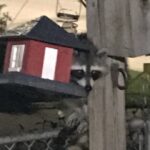
Raccoons are skillful climbers. (Jill photo)
Raccoons were the culprits. Several had raided the night before. Young raccoons are loved everywhere for their “cuteness”. We like them too, but damage can’t be ignored, so we took action.
Amazing Animals
Raccoons are amazingly successful animals. They live nearly everywhere in the continental United States and southern Canada. A few years ago, our son sent us a photo he snapped of a raccoon in a dumpster in our nation’s largest city. They thrive in urban, suburban, and rural areas, especially those that have streams, rivers, or lakes nearby and denning places. Those could be hollow trees, road culverts, or even barns, garages, and house attics.
Raccoons were released in Russia and Japan, where they thrive and are expanding their range. Away from North America they are an invasive species causing ecological problems and probably raiding chicken coops and bird feeders in their new countries.
What do Raccoons Eat?
They are successful, in part, because of their eclectic diet. True omnivores, raccoons enjoy dining on carrion, frogs, crayfish, mice, dog and cat food, birdseed, fruit, and a host of other things, even human food scraps tossed in trash cans.
How We Foil the Raccoons
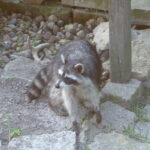
Raccoons forage wherever they find food.
We don’t want to physically harm the raccoons that damaged our bird feeding station so we are doing these things:
- Only put out as much seed as birds eat during the day, so night prowling raccoons find none to munch on. They move on.
- Bring silo, suet and hummingbird feeders inside each evening, so they’re not out to temp nocturnal animals.
- We don’t have a cat or dog but if we did, we would keep their food inside where raccoons cannot get to it.
- We close the sturdy doors that keep raccoons out of our chicken house at night. We’ve also installed heavy wire mesh over the coop’s windows.
- We feed food scraps to our chickens and compost what the hens won’t eat in a “tight” compost bin that raccoons can’t enter. Fortunately, chickens devour the foods raccoons love and shun foods that raccoons also don’t eat. If we had to put food scraps in the garbage, we’d keep the can in the garage where wildlife can’t access it.
Capturing the Culprit
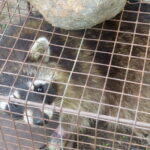
This raccoon readily entered the box trap to eat the sardines.
The night after the raccoons ruined our feeders, we did one other thing. We have a metal box trap that catches, but doesn’t harm, animals. We set it near the feeder with a sardine for bait. A big raccoon went right in. We let him stay there for a while so he could ponder his captivity. Then we sprayed him with water from the hose and opened the trap. He zoomed out like greased lightning, but he may have enjoyed the stay. It was a hot night and the hose water probably cooled him down. We hope he remembers being confined for a short while and stays away.
So far, these actions have worked. Our chickens are healthy and safe. And, no damage to feeders will happen when raccoons prowl.
by Winding Pathways | Apr 16, 2020 | (Sub)Urban Homesteading, Garden/Yard, Nature, Pests
Lyme Disease is something you just don’t want. Rich has had it twice. It was no fun, and he was lucky. Nearly as soon as symptoms appeared, he visited our family physician. She prescribed a powerful antibiotic that worked wonders and left him with no lingering problems. Unfortunately, many Lyme Disease victims suffer pain and fatigue for years. It’s serious.
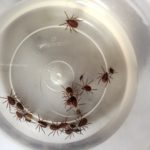
Collection of ticks
Lyme is often transmitted to a human from a bite by a tiny tick that picked up the disease bacteria from an infected white-footed mouse. It once was thought that deer were the primary carrier but mostly they are host to a tiny larval tick that infects a mouse that allows another tick to infect a person.
In theory, eliminating white-footed mice from a yard and home will greatly reduce the odds of transmission of this disease to people. Killing all of them isn’t feasible but reducing their numbers is.
About White-Footed and Deer Mice
White Footed and Deer Mice are amazingly common across much of North America. They’re the cute, native mouse, not to be confused with the common house mouse that originated in the Old World.
White Footeds naturally live in dry temperate forests with brush. That perfectly describes suburban landscaping. It’s likely that five to 20 white-footed mice live in close proximity to most suburban families. They’re nocturnal and rarely seen.
Here are some characteristics:
- They’re hoarders. Find a cache of corn, dog food, or acorns in a shoe or empty can and you’ve found a white-footed mouse cache.
- They reproduce like crazy. A 44-day old female can become pregnant and bear a litter after 22 to 28 days. Babies become independent in three weeks and soon begin having their own babies. Mom often has two to four litters a year.
- They don’t live long. A year-old mouse is elderly.
- Foxes, weasels, hawks, owls, coyotes, and many other predators love dining on mice.
- White Footed mice enjoy coming into homes, where they often find food and enjoy a furnace’s warmth. They can bring with them disease-bearing ticks.
Prudent homeowners carefully manage ticks, in part by reducing white-footed mice numbers. The fewer mice that live near people the lower the odds a person will contract Lyme Disease. So, managing mice and ticks makes for a healthier home and yard. Here are a few tips:
To reduce mouse populations and entry to homes:
- Welcome mouse predators. Karla Bloem, Executive Director of the International Owl Center says, “Two actions people can take to encourage owls are to protect large dead trees that aren’t a threat to people of buildings should they fall. Owls love them. Also, building and erecting an owl house can welcome owls to live near a home and catch and eat mice.” Barred owl nest box plans, and plans for many other birdhouses, can be found at www.nestwatch.org.
- Plug up holes that allow mice to enter a home and replace worn or broken weatherstripping. This is an important fall maintenance that also keeps cold drafts outside and reduces heating bills.
- Avoid feeding mice. They love dining on dog or cat food left in a dish overnight or birdseed left under a feeder. Only feed pets and wild birds what they can eat in a short time. Then, pick up and clean the pet bowl.
- Use snap traps to kill mice in the house. Avoid poison. A poisoned mouse can stagger outside to be caught and eaten by an owl, which can sicken or die from the poison.
A Few More Ways to Reduce Lyme Disease
In addition to reducing mouse numbers and applying a vaccine to keep survivors free of Lyme Disease bacteria here are a few other ways a person can do to reduce odds of infection:
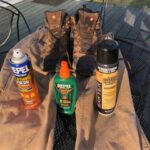
Pants, boots, gaiters and insect repellents help protect from ticks.
Use Permethrin: When applied to clothing, not skin, this chemical repels and kills ticks. Rich purchased several sets of clothing from the Insect Shield Company that are impregnated with permethrin. Supposedly the tick-killing effectiveness lasts for 70 washings. The chemical is also available in spray cans to apply to any clothing.
Do Tick Checks: After being outside, strip down and check the body over for ticks. Then take a hot sudsy shower. Ticks usually crawl around on a person for several hours before biting. A tick merely walking on the skin can’t infect a person.
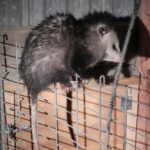
Opossums groom themselves carefully.
Thank and welcome opossums: New research indicates that opossums are tick vacuum cleaners. Ticks climb on them, but these primitive mammals groom often and eat the ticks they remove from their fur and skin. If you have a possum living in the yard be happy.
An Emerging Tool in the Battle Against Lyme Disease
A new product is being developed and tested by a major research company. It is an oral nontoxic vaccine placed in small baits. When strategically positioned around a yard, mice not yet infected with Lyme bacteria eat it and become resistant to the bacteria. Mice uninfected by Lyme can’t spread the disease to a person. If all goes well this product will be on the market by 2021 and may be a major help in reducing human cases of Lyme Disease.
Lyme Disease is an awful condition. Taking precautions to reduce the odds of being infected makes sense.
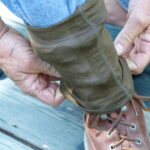
gaiters with tick guard help repel ticks.
by Winding Pathways | Sep 5, 2019 | Nature, Pests
Sometimes the best of intentions turn into a nightmare. A plant down the road from Winding Pathways is proof.
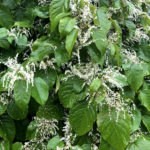
Beware the beauty of Japanese Knotweed.
In the 1840s Philipp Franz von Siebold was in Nagasaki, Japan, and believed a common native plant was so useful and interesting that it should be shared with the world. He shipped cuttings to the Netherlands. The plant thrived and soon gardeners were planting it because of its attractive reddish young leaves, hollow stems somewhat like bamboo, and its showy white flowers that bloom in September. Young shoots are even edible somewhat like asparagus in early spring.
Von Siebold thought he was doing a good thing by bringing this plant to Europe, but soon gardeners realized it was a rapidly spreading monster that crowded out more valuable vegetation. The World Conservation Union calls it one of the worst of the invasives.
It arrived in the United States in the late 1800s as a desirable garden plant, and soon it was found wild in at least 39 states. It’s an invasive problem in England, New Zealand, the United States, and many other countries.
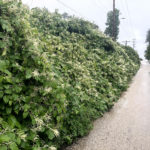
Knotweed forms dense patches and spreads with rhizomes.
Japanese knotweed forms colonies so dense they crowd out all other plants. Rhizomes spread horizontally under the soil surface and soon new plants pop up from them. Early spring shoots have a reddish cast. Leaves are triangular, and the plants quickly grow to four or five feet tall. They are amazingly abundant along streams and lakes. In Iowa, we often see them along roads. They are especially easy to spot when their showy white blooms form in late August and continue into September.
Knotweed is an edible plant in early spring, but anyone with a garden or natural area should be cautious about bringing it home. Drop a node on the ground and it will soon sprout and grow and grow and spread and spread.
Once established Knotweed is hard to control, although continuous mowing should knock it back. It’s something to keep out of the yard, and so far, we’ve been successful at Winding Pathways.
by Winding Pathways | Dec 13, 2018 | Garden/Yard, Pests
Lots of boxelder bugs are traipsing through homes this winter to the consternation of human occupants. We reluctantly share our home with a few during cold months.
This amazingly common and crafty insect is a true bug named for common boxelder tree. You don’t have to have boxelder trees nearby to “enjoy” visits by the bug. Maples and ash trees of several species make suitable hosts. Since these trees are everywhere in suburbia it’s no wonder boxelder bugs pester so many people. The insect makes its living feeding on tree seeds and sap yet poses no threat to its host. Unlike the pests of many other trees, boxelder bugs don’t kill trees.
Come fall box elder bugs prepare for cold weather by tucking themselves into bark crevices to patiently wait out the cold. However, they would rather be warm. If a house is nearby, they seem to sense that soon the furnace will be going and indoors is the best place to overwinter.
How Boxelder Bugs Get In
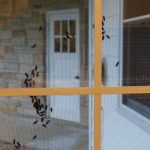
All this winter box elder bugs have gathered on warm sunny sides of homes.
Although they are fairly large insects boxelder bugs can crawl through tiny cracks and holes. Often, they swarm in the sun on the exterior of a house and some manage to find their way inside. Winter is spent idly exploring light fixtures, furniture, and walls.
They are not really a serious pest. Pesky might be a better way to describe them. Boxelder bugs neither bite nor sting. They do sometimes crawl on people and pets. Perhaps their most disagreeable characteristics are pooping and emitting a disagreeable odor if they are crushed. It’s this bad odor that protects them from predators. Hardly anything will eat a boxelder bug.
Getting Rid of Boxelder Bugs in Your Home
Want to rid the house of boxelder bugs? The best defense is a caulking gun. Late each summer seal up cracks that allow them to squeeze into the house. Look for cracks and holes around window and door frames and around wires and pipes leading into the home. Bugs discovered wandering around inside can be vacuumed up, and a shop vac can suck up hundreds sunning on the exterior. Dump them in soapy water and they’ll quickly drown. A hose can also knock them off an exterior wall. Insecticides kill them but perhaps create more problems than they solve. Some people report that spraying them with soapy water also kills them.
We’ve had some success at Winding Pathways in reducing the number of bugs we pick off walls and windows in the winter. We used to bring in a week’s worth of firewood and stack it near the woodstove. For years we didn’t realize boxelder bugs were hiding in the wood. Once they warmed up the insects set out exploring the house. Now we leave wood outside and only bring in a few pieces that go directly into the stove. It’s reduced, but not eliminated, the number of boxelder bugs inside.
Boxelder bugs aren’t harmful, but they are pesky and goofy. Caulking a home’s cracks can encourage them to winter outdoors in trees, rather than in homes. One speaker on Science Fridays quipped, “Boxelder bugs have nowhere to go and all day to get there.”
by Winding Pathways | Nov 29, 2018 | Garden/Yard, Mammals, Pests
After a balmy fall, the television weather report promised near record cold and snow in three or four days. Mice don’t have televisions but somehow, they knew this because several of the tiny mammals successfully entered our house just before cold arrived. One scurried across the floor as we were reading the morning newspaper.
Years ago we read our then young children a delightful book about a mouse in the house. The story goes: “There is a mouse in the house. It is a very nice mouse. It has a long, long tail and shiny eyes. My mother likes the mouse. But, she says, ‘A mouse does not belong in a house.’”
We agree and have developed a strategy to keep them out – at least most of them.
One tactic we do not do is poison. Karla Bloem of the International Owl Center in Houston, MN, reminds us that poison spreads. When a predator eats a poisoned mouse, it absorbs the poison. Over time, the poison builds up and kills the predator. People end up with more mice that can cause problems.
Here’s what we do at Winding Pathways:
- Encourage predators. We love to hear the barred owls call on dark evenings, and occasionally we spot a red-tailed hawk in a tree out the window. Both are outstanding mouse catchers. Owls work the night shift and hawks the day.
- Keep food secure. If mice smell dinner they’ll come right in uninvited and help themselves. It’s important to never leave food out unprotected. We store grain, flour, pasta, cookies and other foods in metal or stout plastic containers with tight-fitting lids. We don’t leave fruits and vegetables on countertops.
- Tighten up the house. Before it gets cold, we check our house over carefully. Any narrow cracks get filled with caulk. If we find a wider crack, we fill it with expanding foam. Often entry points for mice and insects are around pipes and wires leading into the home. Caulk and expanding foam help seal off the entry. Drain pipes sometimes are entry points. “Chore Girl” type metal cleaning pads work great for filling pipes where liquids or air needs to come and go. Wad up the metal pads and jam them into the pipe. Spaces in the cleaning pads let air and moisture enter or leave but keep mice out.
- Bring out the traps. Despite our best efforts, some mice make it into the house. Usually, we don’t see them but do see their calling cards – their tiny black droppings.
Effectively setting traps
Old fashioned mouse traps still catch mice efficiently, but a few tricks make success more likely. (With the exception of the poison information in this website, we have found this information to be appropriate.)
Bait. Probably the best bait is peanut butter. It just takes a tiny dab on the trigger to work.
Placement. Where you set traps is important. Mice naturally run along walls and dart under counters if they can. Traps set in the middle of a room are less likely to catch mice than those set along a wall with the trigger on the wall side.

Place several mouse traps where mice tend to enter.
Double up. It’s usually most effective to set several traps in the same spot. So, set two or three touching each other. The first trap or two might not catch the mouse. Usually one will
Keep setting the traps until you catch no more mice. Often people assume they have one mouse, but likely, there are more. Keep trapping until they’re all gone. We dispose of dead mice by simply tossing them outside for our local opossum to eat. They can be flushed down the toilet. Always be sure to wash your hands after handling mice or traps.
by Winding Pathways | Sep 27, 2018 | Bugs, Nature, Pests
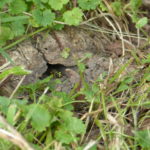
Yellow Jackets work the day shift.
We were recently concerned to find a Yellow Jacket nest close to our front door. Normally we appreciate their ambitious work catching insect prey. If they had made their nest in an out of the way place, we would have left them alone. But, their nest location invited painful stings to us or visitors. They had to go.
Several species of Yellow Jackets live in the United States. Most make an underground nest that can have an opening on the soil surface upwards of an inch in diameter. It can be nearly anywhere, but the nest we found was beneath the lawn next to the walkway into the house.
Yellow Jacket queens overwinter and begin laying eggs in the spring. By late summer or fall, the few Yellow Jackets that were around in spring have multiplied into colonies that can have hundreds of individuals. The workers die in late fall.
Many people discover a Yellow Jacket nest when they walk by it or mow the lawn over the entrance. Angry insects instantly attack and often a hapless person is stung many times in a second or two. Stings really hurt. It’s happened to us more than once, so now we don’t tolerate a nest near the house.
We only kill a Yellow Jacket colony if it’s located where we, or visitors, might be stung. Here’s how we do it:
Yellow Jackets work the day shift. Although they sometimes are out flying in the early evening by dark the entire colony is home underground in the nest. The nest entrance is easily spotted during the day by dozens of Jackets coming and going. We note its location. After dark we approach with a flashlight, spray can of insect killer, and a piece of cardboard, a board, or an old hunk of carpet. The flashlight helps find the hole. We spray a generous amount of poison down the hole, cover it with the carpet, board, or cardboard and weight it down with a rock. The covering keeps the spray in the nest.
The next morning, we watch for Yellow Jacket activity. Usually, there is none, telling us we destroyed the colony. We remove the covering, but if we see some Yellow Jackets we respray at night and cover the nest again. That usually solves the problem.












